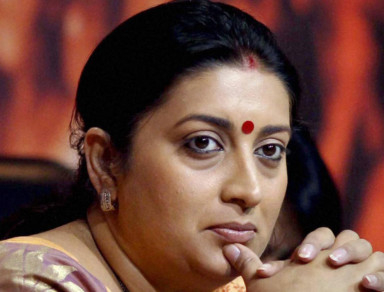
When Smriti Irani was chosen to be India’s Minister for Human Resources Development in Prime Minister Narendra Modi’s cabinet, sceptics immediately pounced on her lack of formal education. Many felt otherwise, for she is feisty, energetic and articulate and these qualities, it was felt, would more than make up for her dubious academic qualifications. Has she shattered these high expectations? Are her oratorical skills being fritted away? Combativeness is a strength but not always. She should get off the back of centres of higher learning like the Indian Institute of Management Ahmedabad (IIMA) and other schools of excellence. And what indeed is the state of higher education in India?
The Congress party’s Mani Shankar Aiyar and the historian Ramachandra Guha have written extensively on Irani’s failings and the trend seen since her appointment of creeping ‘saffronisation’ of education. Many readers may contest the use of the expression ‘saffronisation’ in this context, for it means different things to different people and to some it might seem as an attempt to devalue, deride and mock the glory of ancient India. The study of Sanskrit at the expense of German made headlines recently and Irani’s combativeness was put to good use, as there are scholarly essays that argue that learning Sanskrit can be of great value in computer programming and coding. Ancient India has much to teach modern India and Shashi Tharoor wrote an excellent article extolling the virtues of ancient India but stressing the need for a healthy dose of scientific temper while reading these scripts from antiquity. Sadly it is this recent obsession with Hindu exceptionalism that clouds a fuller understanding of India, modern or ancient. India’s higher education system is impressive but only on paper; though the third largest in the world behind the United States and China, it sadly lacks internationally recognised schools except for a few. And even these appear only in the top 100 or 200, barring the Indian Institute of Science Bengaluru, which ranked 22nd in 2014, the IIMA, which was ranked 7th by the Financial Times in 2011 and the University of Calcutta, ranked 38 in 2005. Incidentally, this was the first multi-disciplinary university in modern India, established in 1857.
The trends seen world-wide show a close linkage between higher educational institutions and research bodies, whether in the private or public domain. There is an umbilical connection here as research drives the surge for excellence and it is a two way process; both sides benefit. India, though an early entrant to scientific research, concentrated heavily on establishing and funding autonomous institutions that until very recently were completely isolated from universities or seats of higher learning. Countries like Taiwan and South Korea, much later entrants, did not make these mistakes and are way ahead of India.
Close scrutiny
Autonomy is another key mantra in spawning world famous universities. W.R. Niblett, Professor of higher education, University of London notes that “The first justification of university autonomy lies here; if any subject is to be studied in a way as to yield truth and insight … it must be studied not just instrumentally but autonomously and this applies to business management and veterinary science”. How does this square with Irani’s drive to throttle the IIM’s autonomy granted to it years ago? The IIMs, and in particular IIMA, need our special attention. The IIM Bill 2015 that Irani is vigorously championing and is the cause of a flurry of debates and public activism requires close scrutiny. First, the two oldest IIMs, Calcutta and Ahmedabad, and others that followed, were created as autonomous institutions for the very reasons put forward by Professor Niblett. They are publicly funded to an extent but they have always been out of reach of the Indian University establishment and that is precisely the reason why they do not have degree awarding rights. Consequently these institutions hand out diplomas but in no way has that dimmed the prestige and recognition conferred on its alumina.
Why then would these institutions give up their hard earned rights? The IIM Bill 2015 has some merits but at the heart of this draft legislation is the overweening craving to control and wield influence on these institutions. And to be fair to Irani this predates her and even her predecessor, the highly educated polymath Kapil Sibal of the Congress party, who was attempting to do the same thing. Recently The Hindu newspaper thundered in its editorial ‘Give IIMs their freedom’ and questioned the purpose of this bill pointing out ominously that the word ‘regulate’ finds repeated mention in the bill.
IIMA was formed in 1961 and the book ‘The IIMA Story’ by Praful Anubhai tells us how it was born, who were the key players and what has made it synonymous with success. Its founding fathers were two famous Gujaratis — Vikram Sarabhai and Kasturbhai Lalbhai — and IIMA was one of the first public-private partnerships in education in India.
Would a prime minister who takes such enormous pride in his Gujarati roots let any harm come to this prized asset? Will Irani, one of Modi’s storm troopers, be asked to step down?
Ravi Menon is a Dubai-based writer, working on a series of essays on India and on a public service initiative called India Talks.









